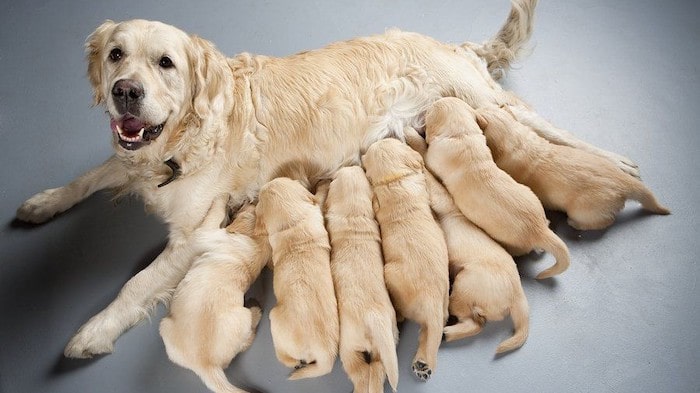Are you expecting a litter of puppies soon? Congratulations! You must be very excited to welcome the new furry members of your family. But you may also have many questions and concerns about your dog’s pregnancy and delivery.
How do you know if your dog is pregnant? How long are dogs pregnant? What do you need to do to care for your pregnant dog and prepare for the birth? How can you help your dog during labor and delivery?
Don’t worry, we’ve got you covered. In this article, we will provide you with all the information you need to know about dog pregnancy and delivery. We will explain how to tell if your dog is pregnant, how long are dogs pregnant, what to expect during each stage of pregnancy, and how to prepare for the delivery.
By the end of this article, you will have a better understanding of what your dog is going through and how you can support her along the way.
How to Tell if Your Dog Is Pregnant: Signs and Symptoms of Canine Pregnancy
“A dog’s pregnancy length (or gestation period) is around 63 days from ovulation, or just over two months” suggest Lauren Jones, VMD from PetMD.

Like people, dogs are pregnant for three trimesters, each about 21 days long. However, unlike people, dogs do not have a reliable way of testing for pregnancy at home. Therefore, you need to look for some signs and symptoms that indicate your dog might be pregnant. These include:
- Changes in vaginal discharge: You may notice changes in the color and consistency of your dog’s vaginal discharge, without any blood. This can be an early sign of pregnancy in dogs.
- Behavioral changes: Your dog may show signs of decreased appetite, reduced energy, increased affection, or general discomfort. She may also become more protective of her territory and more sensitive to noise and touch.
- Physical changes: Around week 4 of pregnancy, you may notice that your dog’s belly swells and begins to lower. Her breasts may also grow bigger and her nipples may become more prominent. You may even see some milk leaking from her nipples.
The most accurate way to confirm if your dog is pregnant is to visit your veterinarian. Your vet can perform a physical examination, a blood test, an ultrasound, or an X-ray to diagnose pregnancy in dogs. These tests can also help you determine how many puppies your dog is carrying and how far along she is in her pregnancy.
How Long are Dogs Pregnant For?
Dogs are pregnant for approximately 62-64 days, or about two months.[1] However, this can vary depending on the breed and litter size of your dog. The length of pregnancy can also be affected by the date of conception, which may not match the date of breeding.
The pregnancy is divided into three trimesters, each lasting about 21 days. Here is what happens during each trimester:
- First trimester (0-21 days): During this stage, the fertilized eggs travel to the uterine horn, where they implant themselves in the lining at about 15-18 days. The embryos start to develop rapidly and form placentas. By the end of this stage, a veterinarian can detect a fetal heartbeat by ultrasound.

- Second trimester (22-42 days): During this stage, the embryos develop into recognizable puppies. They grow organs, limbs, eyes, ears, fur, and claws. They also start to move around in the womb. By the end of this stage, a veterinarian can count how many puppies there are by X-ray.
- Third trimester (43-63 days): During this stage, the puppies continue to grow and mature. They develop their nervous system, lungs, and immune system. They also gain weight and coat color. They become more active and responsive to stimuli. By the end of this stage, the puppies are ready to be born.
What to Expect During Each Stage of Pregnancy
Each stage of pregnancy has its own challenges and risks for both the mother and the puppies. It is important that you monitor the health and well-being of your pregnant dog and provide her with proper care and support. Here are some things you should do during each stage of pregnancy:
- First trimester: During this stage, you should limit strenuous exercise and stress for your dog to enhance the implantation of the embryos. You should also feed your dog a high-quality adult dog food[2], but avoid feeding puppy food until the pups are born. You should also take your dog to the vet for confirmation of pregnancy and prenatal check-up.
- Second trimester: During this stage, you should increase your dog’s food intake gradually, as she will need more calories and nutrients to support the growing puppies. You should also switch to a high-quality puppy food, as it will have the extra protein, fat, calcium, and phosphorus that your dog needs.
You should also continue to exercise your dog moderately, but avoid activities that may cause injury or overheating. You should also take your dog to the vet for another prenatal check-up and X-ray.
- Third trimester: During this stage, you should feed your dog as much as she wants, as she will need a lot of energy for the delivery. You should also provide her with plenty of fresh water at all times. You should also reduce your dog’s exercise level, as she may become less comfortable and more tired.
You should also prepare a whelping area for your dog and her puppies, such as a large, clean, and quiet box with bedding and blankets. You should also take your dog to the vet for a final prenatal check-up and advice on delivery.

During pregnancy, you should also be aware of some common issues or complications that may arise, such as:
- Morning sickness: Your dog may experience nausea or vomiting in the first few weeks of pregnancy due to hormonal changes. This is usually not a cause for concern, unless it is severe or persistent. You can help your dog by feeding her small and frequent meals, avoiding rich or spicy foods, and offering her bland foods like boiled chicken or rice.
- False pregnancy: Your dog may show signs of pregnancy even if she is not pregnant. This is due to a hormonal imbalance that causes her body to mimic pregnancy symptoms, such as enlarged nipples, weight gain, nesting behavior, or even milk production.
This is usually not harmful, but it can be confusing and stressful for both you and your dog. You can help your dog by ignoring her symptoms, avoiding stimulation of her nipples, and distracting her with toys or games.
According to Malcolm Weir, DVM at VCA Hospitals, “Signs of false pregnancy usually begin four to nine weeks after the previous heat period and mimic the signs of true pregnancy.“
- Abortion: Your dog may lose one or more puppies during pregnancy due to various reasons, such as infection, trauma, genetic defects, or stress. This can be very sad and upsetting for both you and your dog. You can help your dog by taking her to the vet for diagnosis and treatment, keeping her comfortable and hydrated, and giving her lots of love and attention.
- Infection: Your dog may develop an infection in her uterus or mammary glands during or after pregnancy due to bacteria or fungi. This can be very dangerous for both the mother and the puppies, as it can cause fever, pain, discharge, or even death.
You can help your dog by taking her to the vet immediately for diagnosis and treatment, keeping her clean and dry, and administering antibiotics or antifungals as prescribed.
- Eclampsia: Your dog may develop a life-threatening condition called eclampsia during or after pregnancy due to low blood calcium levels. This can cause muscle spasms, tremors, seizures, or coma. This is more common in small dogs or dogs with large litters.
You can help your dog by taking her to the vet immediately for diagnosis and treatment, giving her calcium supplements as prescribed, and feeding her a high-quality puppy food.
- Dystocia: Your dog may have difficulty giving birth due to various reasons, such as large or malpositioned puppies, narrow pelvis, weak contractions, or exhaustion. This can be very dangerous for both the mother and the puppies, as it can cause injury, infection, or death.
You can help your dog by taking her to the vet immediately for diagnosis and treatment, assisting her during delivery if needed (such as cutting umbilical cords), and monitoring her closely for signs of distress or emergency (such as prolonged labor or bleeding).
How to Help Your Dog During Labor and Delivery
Most dogs can give birth without any complications or human assistance. However, sometimes things can go wrong and your dog may need your help or veterinary intervention. Here are some tips on how to help your dog during labor and delivery:
- Keep your dog comfortable: Make sure your dog has a clean, warm, and quiet place to give birth. Provide her with fresh water and some food nearby, but don’t force her to eat or drink if she doesn’t want to. Keep other pets and children away from her, but stay close enough to monitor her progress and offer encouragement.
- Keep track of time: Note down the time when your dog’s temperature drops, when she starts contractions, when she delivers each puppy, and when she delivers each placenta. This will help you keep track of how long the labor is taking and if there are any problems or delays.

- Assist with delivery if needed: Most dogs can deliver their puppies by themselves, but sometimes they may need a little help. You can assist your dog by gently pulling on the puppy’s feet or head in sync with her contractions if it is stuck or not coming out after 10 minutes of pushing.
You can also tie off the umbilical cord with dental floss about an inch from the puppy’s belly and cut it with scissors if the mother doesn’t do it herself. You can also rub the puppy with a clean towel to stimulate its breathing and circulation if it is not moving or crying.
- Watch for signs of distress or emergency: If your dog shows any signs of distress or emergency during labor, such as excessive bleeding, prolonged labor (>4 hours), weak or absent contractions, green or foul-smelling discharge, fever, pain, or shock, you should call your vet immediately and follow their instructions. You may need to take your dog and her puppies to the vet for emergency care.
- Clean up after delivery: After your dog has delivered all her puppies and placentas, you should remove any soiled bedding materials and replace them with clean ones. You should also check that all the placentas have been delivered and count them to make sure they match the number of puppies. If there are any missing placentas, they may cause infection in your dog’s uterus and require veterinary attention.
FAQs
If you suspect your dog might be pregnant, it’s crucial to consult a veterinarian. They can perform a physical examination, ultrasound, or hormonal tests to confirm pregnancy
The litter size can vary widely depending on the dog’s breed and size. On average, dogs can have between 1 to 12 puppies in a single litter.
If you notice any signs of distress, discomfort, or abnormal behavior in your pregnant dog, it’s crucial to seek veterinary help immediately. Delaying treatment could be detrimental to both the mother and her puppies.
Properly caring for newborn puppies involves ensuring they stay warm, assisting with nursing if needed, and keeping them in a clean environment. It’s essential to monitor their growth and health closely during the first few weeks.
Well, That’s a Wrap
In conclusion, understanding the duration and care required during dog pregnancy is essential for responsible pet owners. With an average gestation period of 63 days, proper preparation and vigilant monitoring are crucial for the well-being of both the mother and her puppies.
Seeking professional veterinary assistance, providing proper nutrition, and creating a comfortable whelping environment are key factors in ensuring a successful and healthy pregnancy.
By being informed and attentive throughout this journey, we can ensure a safe and joyous experience for our furry companions and their adorable offspring.
Reference:
- Lopate, C. (2014, July 18). Reproductive Physiology of Canine Pregnancy and Parturition and Conditions of the Periparturient Period. Retrieved July 27, 2023. Wiley Online Library
- Nutrition for the pregnant and nursing bitch. (2022, November 18). Animal Health Topics / School of Veterinary Medicine. Retrieved July 27, 2023. UC DAVIS

Ellis is a retired veterinary technician and full-time contributor at DogLovesBest. He likes writing about pet health care tips and reviews the products that are useful for fidos on a daily basis.
Ellis also guardians a Siberian husky, Nova, and a cat named Shilly. They all live happily with his wife Ammy, and both the dogs on a seaside apartment in Queens, NY.
